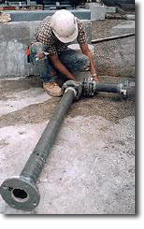 Being a Pipefitter may require many other skills than just pipefitting. Skills that can all be learned with hard work and dedication.
Some Pipefitters become very good welders although usually there is a pipefitter, who fits the pipe together, and a welder who welds the pipe together on most jobs
During the apprenticeship period you learn all about tools, how pipes go together, how pipes are hung from overhead and supported down below. This is all a part of the learning process.
A Welder can be a Pipefitter and a Pipefitter can be a welder, but usually on most projects there is a pipefitter to cut, fit and hang the pipe, and a welder to weld it all together.
A Journeyman Pipefitter has learned all the skills needed for pipefitting and has passed a test to become certified as a pipefitter.
Being a Pipefitter may require many other skills than just pipefitting. Skills that can all be learned with hard work and dedication.
Some Pipefitters become very good welders although usually there is a pipefitter, who fits the pipe together, and a welder who welds the pipe together on most jobs
During the apprenticeship period you learn all about tools, how pipes go together, how pipes are hung from overhead and supported down below. This is all a part of the learning process.
A Welder can be a Pipefitter and a Pipefitter can be a welder, but usually on most projects there is a pipefitter to cut, fit and hang the pipe, and a welder to weld it all together.
A Journeyman Pipefitter has learned all the skills needed for pipefitting and has passed a test to become certified as a pipefitter.
TRAINING
Persons may enter most jobs in the construction industry with out any formal classroom training after High School. Laborers can learn their jobs in just a few days, but the skills required for many jobs can only be learned through experience on the job or through apprenticeship programs.
After several years of experience a person may become a journeyman in a particular craft. That is the top craftsman in a given trade. After many years of training and working in the trade, a worker may become a journeyman in his particular trade. After becoming a journeyman in the trade, the next higher paid job would be foreman. A foreman is usually in charge of a crew of journeymen, helpers and laborers on a construction site. Most foreman direct and work with groups of workers, but still work with tools himself on a project. On larger projects a Superintendent may be required. A superintendent would be over one or more foremen on a project. A job superintendent serves more as a job coordinator and usually does not do manual work himself, but directs others in their work activities.
EXPERINCE
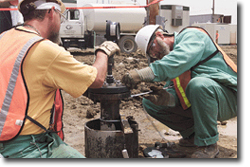 Most all areas of the county have apprenticeship training or Vocational Schools where job skills are taught. Many persons enter the construction crafts through apprenticeship programs. These programs offer on the job training under the close supervision of a craftworker, as well as some formal classroom instructions. Depending on the trade, apprentices learn a variety of skills. Most young people in the construction trades start out as laborers, helpers or apprentices. In order for them to one day become a journeyman in their trade they must have some practical training as in a classroom and on the job training. Once the trainee fulfills all the classroom training and the practical on the job training he then becomes a Pipefitter journeyman. This usually takes around 4 years for the applicant to complete.
Most all areas of the county have apprenticeship training or Vocational Schools where job skills are taught. Many persons enter the construction crafts through apprenticeship programs. These programs offer on the job training under the close supervision of a craftworker, as well as some formal classroom instructions. Depending on the trade, apprentices learn a variety of skills. Most young people in the construction trades start out as laborers, helpers or apprentices. In order for them to one day become a journeyman in their trade they must have some practical training as in a classroom and on the job training. Once the trainee fulfills all the classroom training and the practical on the job training he then becomes a Pipefitter journeyman. This usually takes around 4 years for the applicant to complete.
To develop shills further after training, construction craftsman may work on many different projects. Flexibility and a willingness to adapt new techniques as well as the ability to get along with people are essential for advancement in the trade.
Those with real good organizational skills and exceptional supervisory abilities usually advance to Superintendent status.
The construction industry offers more opportunities than most other industries for individuals who want to own and run their own business. The 1.6 million self employed family workers in 2000 performed work directly for property owners or acted as contractors on small jobs, such as additions.
License and Certification
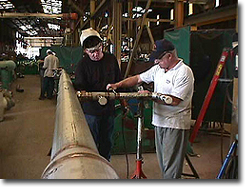 Once a Pipefitter reaches journeyman status he can take a test, usually given by the Municipal Association in a given state to get a journeyman card. With this card he can show proof of his abilities and also with the card he will receive full wages for the trade that he works in.
Once a Pipefitter reaches journeyman status he can take a test, usually given by the Municipal Association in a given state to get a journeyman card. With this card he can show proof of his abilities and also with the card he will receive full wages for the trade that he works in.
After the Pipefitter takes the test and receives a journeyman card he can then take another test to become a Master Mechanic in his given trade. With the master card he can then secure jobs as a foreman or even a superintendent on many job. Most states Municipal Associations recognize Master Cards from other states.
Job Outlook
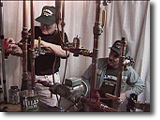 Job opportunities are expected to be excellent as increase demand for skilled Pipefitters is expected to outpace the supply of workers trained in the craft. Employment of Pipefitters is expected to grow about as fast as the average for all occupations through the year 2010. Well trained workers will have especially favorable opportunities. In addition to these demands resulting from employment growth, many positions will become available each year from the need to replace experienced workers who retire or leave the work force for other reasons.
Job opportunities are expected to be excellent as increase demand for skilled Pipefitters is expected to outpace the supply of workers trained in the craft. Employment of Pipefitters is expected to grow about as fast as the average for all occupations through the year 2010. Well trained workers will have especially favorable opportunities. In addition to these demands resulting from employment growth, many positions will become available each year from the need to replace experienced workers who retire or leave the work force for other reasons.
Because construction activities vary from area to area, job openings as well as apprenticeship opportunities fluctuate with local economic conditions. However, employment as a Pipefitter is less sensitive to changes in economic conditions than is other trades. Even when construction activities decline, maintenance, rehabilitation, and replacement of existing piping systems provide many jobs. Employment in overall construction increased by 156,000 jobs since February 2003 to November 2003, while factory jobs decreased by 53,000 for the last 12 months ending August 2003. The following chart shows the projected increase in Pipefitter jobs by 2010.

Source: Bureau of Labor Statistics, Office of Employment Projections; South Carolina Employment Security Commission
WAGES
In 2001 the median wage for a Pipefitter in South Carolina was $15.31 per hour. But 90% of the total Pipefitter work force including Sprinkler Pipefitters and Plumbers had an average hourly wage rate of $21.56 per hour. As of year 2000, the Plumber, Pipefitter, and Steamfitters had 335, 000 jobs which was 5% of the total work force. That is expected to increase by 11% by year 2010, so there should be opportunity for increase wages as the demand or skilled workers increase.

How to interpret wage data; Rank this occupation across all states by median wage.
Source: Bureau of Labor Statistics, Occupational Employment Statistics Survey; South Carolina Employment Security Commission

How to interpret trends
Source: Bureau of Labor Statistics, Office of Employment Projections; South Carolina Employment Security Commission
State Trends: The state trend data are currently not directly comparable to the national trend data.
GENERAL KNOWLEDGE
To be successful in any occupation you have to learn skils of the trade and be knowledgeable in all facets of the trade.
WORK ACTIVITIES
|
Handling and Moving Objects - Using hands and arms in handling, installing, positioning, and moving materials, and manipulating things.
Getting Information - Observing, receiving, and otherwise obtaining information from all relevant sources.
Inspecting Equipment, Structures, or Material - Inspecting equipment, structures, or materials to identify the cause of errors or other problems or defects.
Performing General Physical Activities - Performing physical activities that require considerable use of your arms and legs and moving your whole body, such as climbing, lifting, balancing, walking, stooping, and handling of materials.
Identifying Objects, Actions, and Events - Identifying information by categorizing, estimating, recognizing differences or similarities, and detecting changes in circumstances or events.
Evaluating Information to Determine Compliance with Standards - Using relevant information and individual judgment to determine whether events or processes comply with laws, regulations, or standards.
Monitor Processes, Materials, or Surroundings - Monitoring and reviewing information from materials, events, or the environment, to detect or assess problems.
Controlling Machines and Processes - Using either control mechanisms or direct physical activity to operate machines or processes (not including computers or vehicles).
Repairing and Maintaining Mechanical Equipment - Servicing, repairing, adjusting, and testing machines, devices, moving parts, and equipment that operate primarily on the basis of mechanical (not electronic) principles.
Organizing, Planning, and Prioritizing Work - Developing specific goals and plans to prioritize, organize, and accomplish your work.
|
WORK CONTEXT
|
Spend Time Using Your Hands to Handle, Control, or Feel Objects, Tools, or Controls - How much does this job require using your hands to handle, control, or feel objects, tools or controls?
Wear Common Protective or Safety Equipment such as Safety Shoes, Glasses, Gloves, Hearing Protection, Hard Hats, or Life Jackets - How much does this job require wearing common protective or safety equipment such as safety shoes, glasses, gloves, hard hats or live jackets?
Importance of Being Exact or Accurate - How important is being very exact or highly accurate in performing this job?
Indoors, Environmentally Controlled - How often does this job require working indoors in environmentally controlled conditions?
Spend Time Standing - How much does this job require standing?
Spend Time Kneeling, Crouching, Stooping, or Crawling? - How much does this job require kneeling, crouching, stooping or crawling?
Spend Time Bending or Twisting the Body - How much does this job require bending or twisting your body?
Outdoors, Exposed to Weather - How often does this job require working outdoors, exposed to all weather conditions?
Sounds, Noise Levels Are Distracting or Uncomfortable - How often does this job require working exposed to sounds and noise levels that are distracting or uncomfortable?
Very Hot or Cold Temperatures - How often does this job require working in very hot (above 90 F degrees) or very cold (below 32 F degrees) temperatures?
|
BASIC SKILLS
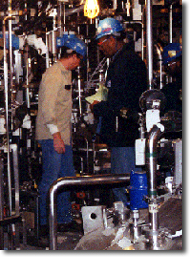 When a young person enters the contracting field with little or no knowledge of the skills required, he starts out as a laborer, helper, or apprentice. As he works and studies where possible, he slowly learns more and more about the craft he has chosen for his career.
When a young person enters the contracting field with little or no knowledge of the skills required, he starts out as a laborer, helper, or apprentice. As he works and studies where possible, he slowly learns more and more about the craft he has chosen for his career.
To become a top paid Pipefitter there are many different types of pipe and processes by which pipe is installed, how you apply them to different systems in a building and apply them to different mechanical systems.
There is copper pipe, which comes in three classifications, type L, type M and type K. Not only do you have to learn how to install each of these types of copper and what fittings are used with them, you also have to learn where each type is used. All Copper pipes are soldered together. In a building Chill Water System and Hot Water System, most of the time pipes 2" and smaller above grade are made of Type L copper. If under grade, type K copper.
There is steel pipe. One would have to learn that in come cases it is screwed together and in other cases it would be welded. This is part of the learning process to become a Pipefitter journeyman. Of course there are many more different kinds of pipe, which use many different applications for installation, and it will be up to the apprentice pipefitter to learn these.
Another part of basic skills is learning how to read blueprints. Blueprints are the road map of construction, which shows where everything is going in a building that is to be constructed. A pipefitter has to be able to look at the plans and visualize the pipe installed and coordinate with other trades so as not to interfere with their installation and so they will not interfere with the installation of the pipe.
Knowledge of all these various kinds of pipe and how they are installed in a building comes with experience, on the job training and classroom training when available.
|